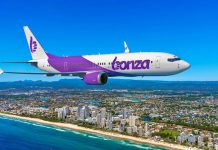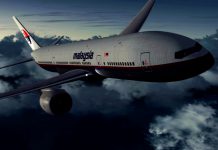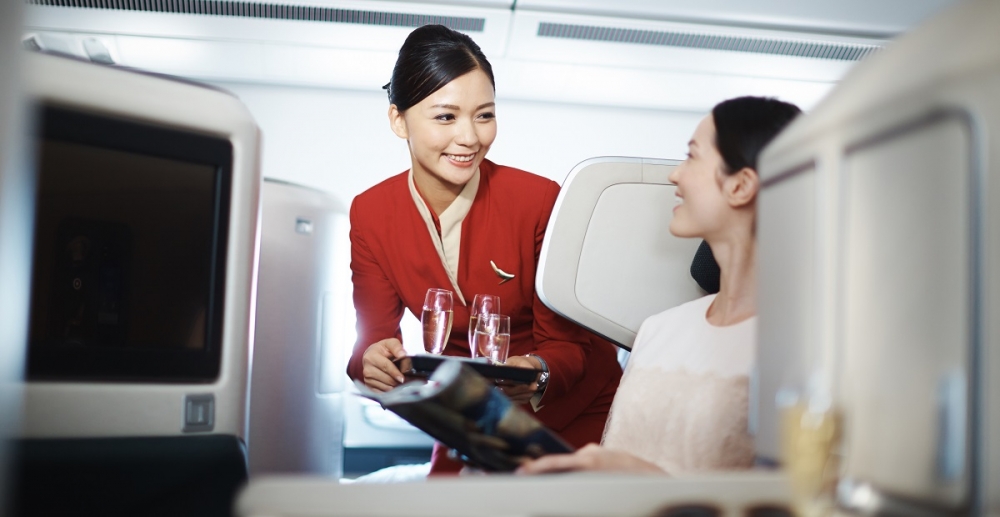Cathay Pacific A350-900, CX 705, Hong Kong-Bangkok, July 24.
Hong Kong’s international airport is quiet at 5am, the lighting subdued, the shops closed and the crowds thin. I’m trudging through the shuttered shops after discovering I’ve followed the wrong signs to the wrong lounge and I’ve cleverly positioned myself on the wrong side of the airport.
My goal is the latest widebody product from European aerospace giant Airbus and, after navigating what seems to be the world’s longest corridor and an endless succession of travellators ( I later discover I could have taken a people mover), it sits waiting for me at Gate 67.
The Airbus A350-900 XWB (extra wide body) is the new kid on the block and I’m taking my first revenue flight on a Cathay Pacific service between Hong Kong and Bangkok. There are only a handful operating in the world at this stage— about 30 had been delivered to seven operators by June 30 — but hundreds more will enter service over the coming years and the A350 will be coming to an airport near you.
The A350 is the competitor to Boeing’s increasingly ubiquitous 787 and you can pick it by the graceful aerodynamics of its curved wingtip. For plane junkies, this is much a piece of art as it is a feat of engineering. The new wing design combines with other aerodynamic and system improvements as well as a carbon fibre fuselage and fuel-efficient Rolls Royce engines to deliver a 25 per cent reduction in fuel burn over the aircraft it replaces.
Along with reduced maintenance requirements, this means a plane that is significantly cheaper to operate. Cathay ordered 22 -900s, 12 of which are due for delivery by the end of the year, in addition to 26 of the bigger A350-1000s.
The plane edged out the 787 is a tight competition and Cathay has been putting it through its paces and training crew on high turn-around shorter routes prior to launching long-haul flights to Europe in September. While it’s still early days, the airline has worked with Airbus to stay on top of maturity issues and is happy with the performance. It was the sixth operator to take the A350 and the head of the airline’s A350 program, Robert Taylor, says some early problems with the type were fixed by the time it received its planes.
“It’s quite a tough workout and, bearing that in mind, the aircraft’s performing well,’’ says Taylor. “The aircraft had an initial target of 98.5 per cent technical dispatch reliability for the first year and it’s around about that figure, and it’s around about that figure worldwide.’’
Pilots like it too: Cathay deputy chief pilot Evan Summerfield says flying the jet is “absolutely fantastic”.
The aircraft has more electrical systems than the A330 and Summerfield says the main differences come prior to push-back. “Just setting up is lightly different with regards to the amount of interface there is with the on-board information systems and the EFB (electronic flight bag),’’ he says. “It’s all very straight forward. Once you actually release the park brake and you’re pushing back from the gate, it could be any Airbus –whether it’s an A330 or A340 – it’s very, very similar. If anything it’s lot more redundant, a lot more clever and just a lot nicer to fly.’’
For passengers, the new breed of plane is quieter, better able to handle turbulence and operates with a lower altitude cabin air pressure that allows you to come off a flight feeling more refreshed and less like a refugee from The Mummy Returns.
Manufacturers are often blamed for seating but It’s up to individual airlines how many seats they cram in and how comfortable they make passengers in terms of space. Cathay has erred on the generous side in this respect with three refreshed cabins that sees the A350 equipped with 38 business class suites, 28 premium economy seats and 214 in the main cabin.
I’m in business in seat 16A on this relatively short flight of just over two hours. The overwhelming impression as I enter the business cabin is one of space. The vertical walls and larger windows make the 280-seat plane, already touted as the widest in its class, seem even bigger than it is.
The outsize luggage bins lining the side of the cabin are big enough to take roller bags on their side, meaning plenty of overhead storage, and the 1-2-1 configuration means everyone gets aisle access from the 38 thoughtfully-designed business class seats.
The Studio F.A. Porsche-designed seats are based on the airline’s existing offering but offer a slew of refinements. There’s more padding, more in-seat storage, redesigned controls and a stunning 18.5-inch high definition touchscreen that uses the latest software to emulate a tablet.
Shoes can be happily stowed under the ottoman and there’s a compartment to one side that can take a laptop and documents while the cabinet in which the noise-cancelling headphones are stored now also contains power and USB ports and also has room for spectacles and a phone.
The water bottle is out of the way in a “hidden’’ compartment in the retractable armrest while the easy-to-use seat controls and dimmable reading light are on the side of the seat with a touchscreen video handset that can play content independently from the entertainment system.
Privacy is a big factor in this design and you are not really aware of your fellow travellers. The other thing of which you’re not really aware is noise: there isn’t much.
Airbus says the cabin is 50 per cent quieter than older aircraft in terms of perceived noise — think top deck of an Airbus A380 — and this one space where you can hear yourself think. Whether it is quieter than its competitor is difficult to discern but there wouldn’t be much in it. Although not noticeable on our short flight, the lower cabin altitude of 6,000ft, compared to as much as 8000ft in some other planes, helps fight jetlag and will be a nice plus on long range routes to Europe.
There are some jazzy features in the A350 cabin such as mood lighting with millions of colours, although the use of this tends to be muted during a daylight flight, and liquid crystal displays where the seat belts signs normally would be.
The seat is comfortable and a great design for people who sleep on their sides which, according to airline’s research, is more than half of us. The 75 -inch (190cm) long lie-flat bed slots snugly in with the padded area on top of the laptop stowage to provide a swathe of space at knee level and allow side sleepers to curl up comfortably. Simple, intuitive controls make setting up the bed a breeze.
The responsive touch screen is razor sharp and Panasonic’s user-friendly interface makes it easy to navigate. Cathay has expended its programming and is making it available on shorter flights across its fleet. In addition to a good choice of films and music, the A350’s system included 3-D maps, views outside the plane, e-zines, and live satellite news feeds from the likes of CNN and the BBC.
Those wanting their regular online fix can access the Internet for $US9.95 for one hour’s continuous usage or shell out a more cost-effective $US12.95 for flights of six hours or less and $US19.95 for longer flights. Access is a bit slower than ground-based broadband but good enough for emails and Web surfing. The airline is also offering data roaming from your own mobile phone (you pay the roaming charges) but does not allow voice calls.
Service on the breakfast flight was up to Cathay’s usual high standard: friendly and efficient with hot towels and welcome drinks out quickly. A tasty full breakfast included fresh seasonal fruit, yoghurt, a choice of two hot mains and brewed coffee.
If anything, the flight was too short but it was enough to indicate Cathay’s new fleet of A350s is going to make flying to Europe via Hong Kong a serious option.
Steve Creedy flew to Bangkok courtesy of Cathay Pacific.
























